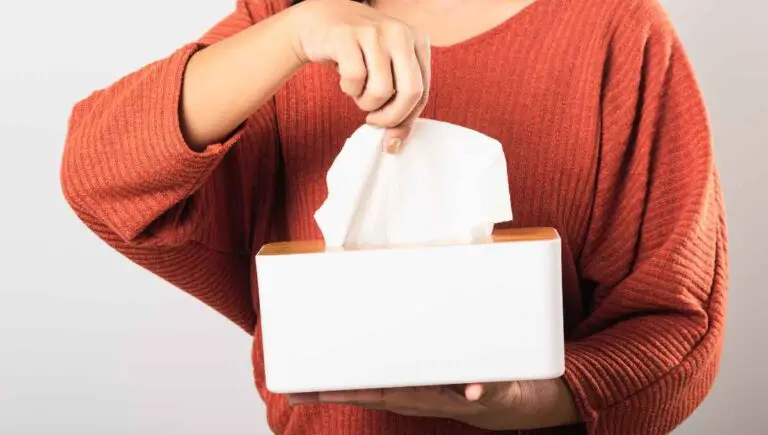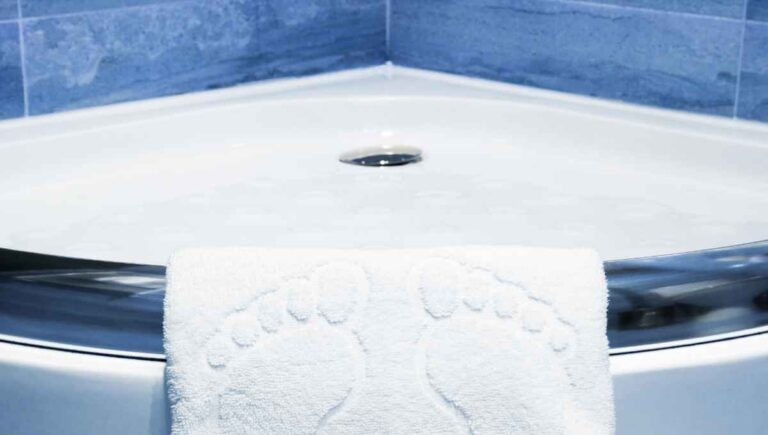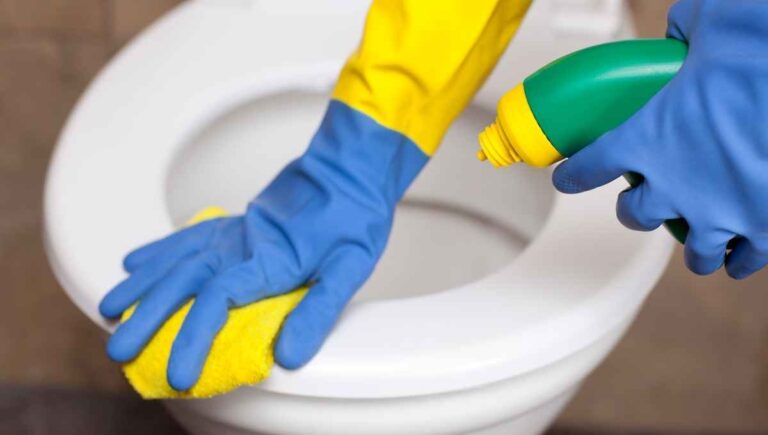Is It Safe to Put Antifreeze in Toilets? (Use This Kind)

Winter is coming, and we all know that the growing danger of frozen pipelines is getting stronger. This includes the risk of having frozen toilet pipes. So, is it safe to put antifreeze in your toilet to prevent it from having an ice clog?
You can safely put antifreeze in your toilet to protect it from freezing, but you’ll need to use a special type of antifreeze. Regular antifreeze contains ethylene glycol, which is toxic and corrosive to sewage pipelines. Therefore, you need to get antifreeze made from propylene glycol instead.
Getting the right information before insulating your home or RV has become essential. So, in this article, we’ll discuss what you can put in your toilet to prevent it from freezing and what kind of antifreeze is safe for toilets. We’ll also go over what to avoid and the right way to winterize your toilet.
This post contains affiliate links. This means Household Blogger may earn a commission should you make a purchase using any of our links. Please refer to our full affiliate disclosure policy for full details.
Here’s a Quick Pro Tip!
You can use antifreeze to protect your toilet and your bathroom drains, but it can’t be just any type of antifreeze. Instead, you’ll need a non-toxic antifreeze often labeled as RVantifreeze or Plumber’s antifreeze.
Make sure to keep these around you for when winter comes or for the next time you need to put antifreeze into a toilet tank:
1. Eco-friendly Antifreeze – If it’s safe for you, it’s safe for the pipes.
2. Non-toxic RV Antifreeze – Ready to fight some ice.
3. Star Brite Bio-Safe Antifreeze – You won’t need to worry about protecting your plumbing with strong chemicals. This antifreeze is pet-safe and environment-friendly so you can use it without guilt!
What Can Go in a Toilet
Let’s explore whether or not you can put antifreeze on your toilet before getting into the juicy details of the benefits of winterizing your pipes.
What Can I Put In My Toilet to Keep It From Freezing?
To keep your toilet from freezing, you can use a non-toxic antifreeze. Most of them come in the form of RV antifreeze. RV antifreeze is safe for your toilet and for the sewer system, unlike most vehicle types of antifreeze.
Antifreeze is a chemical solution that is mainly used for vehicle engines. Their purpose is to protect car engines from freezing during winter.
But, this type of antifreeze is not suited for home plumbing because they damage the sewage system. Instead, purchase a brand safe for a sewer system.
Can You Put Antifreeze in a Toilet to Keep It From Freezing?
You can put antifreeze in your toilet, but not just anywhere. Furthermore, you can’t use all types of antifreeze because of the chemicals they may contain. Thus, finding a plumber’s antifreeze is best because it’s usually non-toxic and effective at preventing your toilet from freezing.
Even though many people have mistakenly used automotive antifreeze in their toilets, it’s not recommended.
This is because automotive antifreeze can contain ethylene glycol, which is known for damaging sewage pipes.
Moreover, you can’t put antifreeze directly inside your toilet. Instead, you have to drain the toilet tank’s water and then drain the water remaining on the toilet bowl.
Afterward, apply at least one pint of antifreeze inside the flush valve.
Can I Flush Antifreeze Down a Toilet?
You can flush antifreeze down a toilet, but you need to do it properly, without water in the bowl. Having water in the bowl will prevent the antifreeze from properly protecting your toilet’s piping. That is why it’s essential to, first and foremost, investigate the proper way to apply non-toxic antifreeze to your toilet’s tank.
The correct way to flush antifreeze down your toilet is as follows:
1. Shut its water supply and drain the water from inside the bowl.
2. Pour the antifreeze directly into the bowl.
3. Flush the toilet. You may need to flush more than once to get all the antifreeze out of the bowl.
4. Turn the water back on if the toilet will be used, or leave it off if winterizing.
5. If the toilet will be used again, be sure and let it sit for a while before attempting to use it.
Why Do People Put Antifreeze in Toilets?
People put antifreeze in their toilets because it prevents the toilet from freezing. However, some apply it incorrectly and therefore cause it not to provide the protection their pipes require. And, often, they use the incorrect type of antifreeze.
The correct type of antifreeze that people should use for their toilets has to be made out of propylene glycol instead of ethylene glycol. Ethylene glycol is highly toxic and, therefore, not recommended for use in a toilet.
What Is Plumbers Antifreeze?
Plumbers antifreeze is a form of antifreeze designed specifically for house plumbing. It’s often non-toxic and made from water, alcohol, and propylene glycol products. As a result, they help avoid freezing pipes and other headaches.
Plumber’s antifreeze offers protection to your pipes. It can protect your pipes even when temperatures drop to -50°F.
They’re also safe for PVC pipelines and more effective when used undiluted. As a result, it’s suitable for residential plumbing.
Will Antifreeze Hurt PVC Pipes?
Whether your antifreeze hurts your PVC pipes will highly depend on the type of antifreeze you use. For example, using automotive antifreeze for residential plumbing is not recommended. In contrast, RV antifreeze is more recommended for PVC and won’t hurt the pipes.
Ethylene glycol-based antifreeze is unsuitable for indoor plumbing because it can damage the sewage system. But, you can use non-toxic antifreeze, often referred to as RV antifreeze.
These won’t damage or corrode your plastic pipes. In fact, this type of antifreeze is only made for plastic pipes, so you’re in luck.
Can I Put Antifreeze in a Toilet to Prevent Freezing?
You can put antifreeze inside a toilet tank, but not on the toilet bowl itself. This is because the water inside the toilet will lower the protection capacity of the antifreeze. Thus, it won’t protect your toilet from freezing in such conditions.
In short, you can use antifreeze to prevent your toilet from having a frozen clog. But, you have to know how to use it and the correct quantity you should apply to your toilets.
If you’re not cautious about these steps, you may not protect your pipes.
Can You Use RV Antifreeze in a Toilet?
You can use RV antifreeze to protect your toilet from frozen temperatures. Indeed, it’s more recommended to use this type of antifreeze because it’s non-toxic. And it won’t damage the sewage piping system.
RV antifreeze is more fit for your toilet than ethylene glycol antifreeze. It doesn’t have the harsh chemicals that have the potential to damage your plumbing.
So, if you need to use antifreeze, aim to look for one of these.
Does Antifreeze Stain Toilets?
Antifreeze has the potential to stain toilets when they’re not wiped quickly. If you leave an antifreeze stain inside the toilet’s tank or bowl after applying it correctly, you have to clean it before it hardens. If not, it will likely make a tough stain on your toilet.
After you learn how to apply antifreeze correctly and then proceed to do it, you have to make sure that, during the process, you clean any remaining antifreeze from your toilet.
Wipe them with an old cloth, and try to leave no spots. It’ll save you from further stress.
How to Add Antifreeze
Now you know that you can use antifreeze, but just not any antifreeze. Yet, how can you pour antifreeze safely on a toilet?
Remember that with any project that involves chemical items, you should protect yourself. So, let’s talk about the process below.
How Do You Use Antifreeze in a Toilet?
Antifreeze is a liquid substance made to protect your toilet. So, use it for your toilet by pouring it directly inside the flush valve inside the toilet tank. Make sure to turn off your toilet water supply and drain the water prior to that.
After draining all of your toilet’s water:
- Put one pint of antifreeze inside the flush valve.
- Let it flush into the toilet bowl, and later flush again to let the antifreeze go to the pipes.
- Wipe everything to avoid staining your toilet.
How Much Antifreeze to Put in a Toilet?
You have to put at least one pint of Plumber’s antifreeze inside your toilet. Adding more or less than the recommended quantity may affect how antifreeze protects your toilet. Doing so will defeat the purpose of antifreeze.
Most plumbers recommend that you only add one pint of antifreeze to your toilet. But remember that you will apply it in the tank area, specifically the flush valve.
So, don’t throw it directly into the toilet bowl without proper instructions.
How to Add Antifreeze to a Toilet?
To add antifreeze to a toilet, you have to shut off the toilet water supply. Later, flush the toilet to drain all of the water from the inside of the tank and toilet bowl. Then, use a sponge to eliminate the remaining water.
After getting the remnants of water out:
- Pour the antifreeze inside the flush valve located in the tank.
- Let it flush into the toilet bowl to get to the pipes.
- When done, wipe out excess antifreeze marks to prevent them from staining your toilet.
Wear safety goggles and rubber gloves to protect your eyes and skin from getting in contact with the antifreeze. You also want to avoid smelling it directly, as inhaling it can harm you.
Always store it somewhere safe and out of reach of children.
How Do You Put Antifreeze Down a Toilet?
To put antifreeze down a toilet, you have to pour the antifreeze directly inside the flush valve. The flush valve is located inside the toilet tank. So, first, let the antifreeze flush down to the bowl, and later let it reach the toilet’s drainpipe.
Of course, you have to do this after turning off the toilet’s water supply lines. And, you have to make sure to drain the water effectively, lest it affects how your antifreeze works.
Additionally, always take safety measures when dealing with antifreeze.
Sewers and the Environment
Have you ever wondered what would happen if antifreeze went down the sewer? Of course, with non-toxic antifreeze, there shouldn’t be any problem.
Yet, we can’t say the same thing about regular antifreeze. So let’s talk about it below.
Can I Dump RV Antifreeze Down the Toilet?
You can safely dispose of RV antifreeze by pouring it down the toilet. This is because it’s non-toxic and won’t damage your pipes. But, avoid doing this with antifreeze that contains a chemical named ethylene glycol.
RV or Plumber’s antifreeze can be thrown down the toilet if you mean to dispose of it. But, you can’t do this with regular antifreeze.
If you want to dispose of regular antifreeze, consult your local government authorities to get proper disposal information.
You might also enjoy our post on Can You Put Soap in the Toilet?
Can Antifreeze Go in a Sewer?
It’s strongly advised against disposing of antifreeze inside a sewer or septic system. It doesn’t matter whether it’s toxic or non-toxic. By word of law, certain states regulate the proper way to dispose of antifreeze.
For example, the Minnesota Pollution Control Agency has an official statute on how to dispose of antifreeze.
They also provide Minnesota citizens with all the offices they can contact if they want to dispose of toxic antifreeze and other forms of waste.
Will RV Antifreeze Hurt a Septic System?
You can safely use RV antifreeze in a septic system without hurting it. But, you have to be cautious about the amount you’re going to throw in. Too much antifreeze can be detrimental to the septic system.
RV antifreeze is non-toxic and unlikely to damage your septic system unless you overdo it.
In the case of regular ethylene-glycol antifreeze, it’s a big no-no to add it to the septic system because it has a strong potential of damaging it.
How Do I Get Antifreeze Out of My Freshwater Tank?
To get antifreeze out of your RV’s fresh water tank, open your RV’s faucets and let the water run until the pink color of the antifreeze fades. Then, you have to refill the fresh water tank.
Here are the full steps to follow to remove antifreeze from a freshwater tank:
- Check that your water drain valve is off.
- Use a garden hose to fill up the freshwater tank to a third full of water.
- Take the hot water plug out and make sure it has a new Teflon tape. Teflon tape is needed to prevent possible leakage.
- Put the plug on the hot water tank using a 1/16th socket. Make sure to tighten it, but be cautious of overdoing it.
- Get inside the trailer, and locate the water pump. Turn it on and let it build pressure. Make sure it has no leaks.
- Once the water pump builds pressure, start opening all the faucets from inside your RV. Go one by one until the pink color of the antifreeze fades. And, make sure to check the outside shower too.
- Make sure to flush the RV toilet too.
- Once antifreeze is out of your freshwater tank, turn on the hot water bypass to fill it.
Winterizing
It’s important that we protect our pipelines during the winter season, but we must do it carefully. Not knowing the right steps to do it can lead us to make wrong decisions that can be hard to fix later on.
So, let’s learn how to winterize our toilets below.
How Do You Winterize a Residential Toilet?
You can buy Plumber’s antifreeze to winterize your toilet. You should also insulate your bathroom plumbing. This way, you’ll prepare your plumbing for winter and avoid dealing with freezing pipelines and other misfortunes.
If you don’t prepare well for winter, chances are that your pipelines will freeze. So prepare a good plan to insulate your pipes before winter to avoid dealing with frozen pipes.
How Do I Winterize My Toilet and Pipes?
To winterize your toilet, make sure to insulate all of your pipes before the winter season comes. And, get an RV or Plumber’s Antifreeze to help your toilet prepare for winter. You can find one at your local RV shop or online.
You can find a non-toxic antifreeze on Amazon.
Just make sure to read the label before purchasing so that you don’t make the mistake of buying an ethylene glycol-based antifreeze, which could harm your pipes.
How Do You Winterize a Toilet With a Septic System?
To winterize a toilet with a septic system, you have to winterize all the pipes connected to the septic system. To do this, drain all the water from the septic system and make sure to add antifreeze suited for it.
An inspector can give you better insight that can help you understand the correct way to winterize your septic system.
Moreover, the antifreeze you will use has to be made for septic systems. Otherwise, you risk damaging it.
What Can I Put In My Toilet to Keep It From Freezing?
Pour antifreeze on the toilet’s flush valve to winterize it and keep it from freezing. Make sure to do it after all the toilet water is drained, both from within the tank and the toilet bowl. Also, make sure to use an RV or non-toxic antifreeze.
You can safely use antifreeze to keep your toilet from freezing, so long as it’s propylene glycol-based.
This is important because you’ll avoid dealing with highly toxic chemicals, such as ethylene glycol, which isn’t safe for pipes.
You might also enjoy our post on Can a Bathtub Drain Freeze?
Related Questions
Can Cold Weather Affect Toilet Flushing?
Cold weather can affect toilet flushing if the lack of flush is due to a frozen pipe. When the pipes are not properly insulated, the chances are that they’ll freeze from cold temperatures. And, if there is a leak, there is a higher chance of it clogging.
Cold temperatures are the number one enemy of pipes. Luckily, there are things that you can do to unfreeze them.
Regardless, it’s better to prevent it by checking the insulation of your pipes to prevent leaking.
What Happens if You Dump Antifreeze?
Suppose you dump antifreeze anywhere without caring for the environment or other earthly elements it may affect. In that case, there is a high chance it’ll attract animals that want to consume it. As a result, they will be poisoned with antifreeze.
There is a very good reason why many state laws regulate the proper ways of disposing of antifreeze, especially if we’re talking about toxic vs. non-toxic antifreeze.
It can harm the environment and all the animals or pets that live in it. So, you better check out for those things before throwing your antifreeze away.
How Do You Unfreeze a Toilet?
To unfreeze a toilet, you should first locate the frozen pipe responsible for its clogging. Once you do this, you can explore multiple options to unfreeze it, such as applying heat with a heating pad or a hairdryer.
Here are five things you can use to unfreeze your toilet:
- Heating pads
- Hot towels
- Hairdryer
- Heat tape
- Space heater
Moreover, you can also mix hot water with salt and pour it down the drains. The salt will melt the ice, and the hot water will help unfreeze it effectively.
But, be careful: this isn’t recommended for PVC pipes!
Is It Safe to Put Antifreeze in Pipes?
The safety of the antifreeze that you put inside your pipes depends on the antifreeze you choose. For example, if you choose an automotive antifreeze, the chances are that it will damage the sewage pipelines.
Using ethylene-based antifreeze for your pipes is strongly discouraged and should be avoided at all costs. This can damage the sewage system, as explained in this news report.
Be sure you know what you’re using before dumping it down your pipes!
Final Thoughts
You can use non-toxic antifreeze to protect your toilet from freezing. First, turn off the water supply, drain the water from the tank and the toilet bowl, and add the antifreeze inside the flush valve.
Let it sit for a few minutes until it gets to the toilet’s drain.
Remember, however, that you’ve got to be careful about the antifreeze you choose. For example, you can’t use ethylene glycol antifreeze for your pipes because it may harm the sewage system, and you don’t want to do that.
We hope this helps you next time you winterize!













